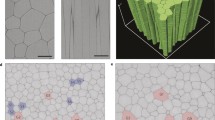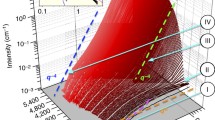Abstract
Spherulites are spherical clusters of radiating crystals that occur naturally in rhyolitic obsidian. The growth of spherulites requires diffusion and uptake of crystal forming components from the host rhyolite melt or glass, and rejection of non-crystal forming components from the crystallizing region. Water concentration profiles measured by synchrotron-source Fourier transform spectroscopy reveal that water is expelled into the surrounding matrix during spherulite growth, and that it diffuses outward ahead of the advancing crystalline front. We compare these profiles to models of water diffusion in rhyolite to estimate timescales for spherulite growth. Using a diffusion-controlled growth law, we find that spherulites can grow on the order of days to months at temperatures above the glass transition. The diffusion-controlled growth law also accounts for spherulite size distribution, spherulite growth below the glass transition, and why spherulitic glasses are not completely devitrified.









Similar content being viewed by others
References
Carmichael I, Turner F, Verhoogen J (1974) Igneous petrology. McGraw-Hill, New York, p 739
Castro J, Manga M, Martin M, (2005) Vesiculation rates of obsidian domes inferred from H2O concentration profiles. Geophys Res Lett 32:L21307
Castro J, Beck P, Tuffen H, Nichols A, Dingwell D, Martin M (2008) Timescales of spherulite crystallization in obsidian inferred from water concentration profiles. Am Mineral (submitted)
Cross W (1891) Constitution and origin of spherulites in acid eruptive rocks. Philos Soc Wash Bull 11:411–449
Davis B, McPhie J (1996) Spherulites, quench fractures and relict perlite in a Late Devonian rhyolite dyke, Queensland, Australia. J Volcanol Geotherm Res 71:1–11
Fenn P (1977) The nucleation and growth of alkali feldspars from hydrous melts. Can Mineral 15:135–161
Freer R (1981) Diffusion in silicate minerals and glasses: a data digest and guide to the literature. Contrib Mineral Petrol 76:440–454
Ghiorso M, Sack R (1995) Chemical mass transfer in magmatic processes. IV. A revised and internally consistent thermodynamic model for the interpolation and extrapolation of liquid–solid equilibria in magmatic systems at elevated temperatures and pressures. Contrib Mineral Petrol 119:197–212
Gonnermann H, Manga M (2003) Explosive volcanism may not be an inevitable consequence of magma fragmentation. Nature 426:432–435
Granasy L, Pusztai T, Gyorgy T, Warren J, Douglas J (2005) Growth and form of spherulites. Phys Rev 72:011605
Judd J (1888) On the volcanic phenomena of the eruption, and on the nature and distribution of the ejected materials, Part I. In: Symons GJ (ed) The eruption of Krakatoa committee of the royal society. Harrison & Son, London, pp 1–46
Keith H, Jr Padden F (1963) A phenomenological theory of spherulitic crystallization. J Appl Phys 34(8):2409–2421
Keith H, Jr Padden F (1964a) Spherulitic crystallization from the melt. I. Fractionation and impurity segregation and their influence on crystalline morphology. J Appl Phys 35(4):1270–1285
Keith H, Jr Padden F (1964b) Spherulitic crystallization from the melt. II. Influence of fractionation and impurity segregation on the kinetics of crystallization. J Appl Phys 35(4):1286–1296
Kirkpatrick R (1975) Crystal growth from the melt: a review. Am Mineral 60(9–10):798–814
Langer J (1980) Instabilities and pattern formation in crystal growth. Rev Mod Phys 52:1–27
Lewis-Kenedi C, Lange R, Hall C, Delgado-Grenados H (2005) The eruptive history of the Tequila volcanic field, western Mexico: ages, volumes, and relative proportions of lava types. Bull Volcanol 67:391–414
Lofgren G (1971a) Spherulitic textures in glassy and crystalline rocks. J Geophys Res 76:5635–5648
Lofgren G (1971b) Experimentally produced devitrification textures in natural rhyolite glass. Geol Soc Am Bull 82:553–560
MacArthur A, Cas R, Orton G (1998) Distribution and significance of crystalline, perlitic and vesicular textures in the Ordovician Garth Tuff (Wales). Bull Volcanol 60:260–285
Manley C (1992) Extended cooling and viscous flow of large, hot rhyolite lavas: implications of numerical modeling results. J Volcanolgy and Geotherm Res 53:27–46
Manley C, Fink J (1987) Internal textures of rhyolite flows as revealed by research drilling. Geology 15:549–552
Martin M, McKinney W (1998) The first synchrotron infrared beamlines at the advanced light source: microspectroscopy and fast timing. Proc Mater Res Soc 524:11
Mittwede S (1988) Spherulites in the Spring Branch Rhyolite, Western Saluda County, South Carolina. South Carolina Geol 32:21–25
Mullins W, Sekerka R (1963) Morphological stability of a particle growing by diffusion or heat flow. J Appl Phys 34:323–329
Neuville D, Courtial P, Dingwell D, Richet P (1993) Thermodynamic and rheological properties of rhyolite and andesite melts. Contrib Mineral Petrol 113:572–581
Newman S, Stolper E, Epstein S (1986) Measurement of water in rhyolitic glasses: calibration of an infrared spectroscopic technique. Am Min 71:1527–1541
Riehle J, Miller T, Bailey R (1995) Cooling, degassing and compaction of rhyolitic ash flow tuffs: a computational model. Bull Volcanol 57:319–336
Ryan M, Sammis C (1981) The glass transition in basalt. J Geophys Res 86:9515–9535
Smith R, Tremallo R, Lofgren G (2001) Growth of megaspherulites in a rhyolitic vitrophyre. Am Mineral 86:589–600
Stevenson R, Briggs R, Hodder A (1994) Physical volcanology and emplacement history of the Ben Lomond rhyolite lava flow, Taupo Volcanic Centre, New Zealand. N Z J Geol Geophys 37:345–358
Stolper E (1982) Water in silicate glasses: an infrared spectroscopic study. Contrib Mineral Petrol 81:1–17
Swanson S (1977) Relation of nucleation and crystal-growth rate to the development of granitic textures. Am Mineral 62:966–978
Swanson S, Naney M, Westrich H, Eichelberger J (1989) Crystallization history of Obsidian Dome, Inyo Domes, California. Bull Volcanol 51:161–176
Westrich H, Stockman H, Eichelberger J (1988) Degassing of rhyolitic magma during ascent and emplacement. J Geophy Res 93:6503−6511
Zhang Y, Behrens H (2000) H2O diffusion in rhyolitic melts and glasses. Chem Geol 169:243–262
Zhang Y, Belcher R, Ihinger P, Wang L, Xu Z, Newman S (1997) New calibration of infrared measurement of dissolved water in rhyolitic glasses. Geochim Cosmochim Acta 63(15):3089–3100
Acknowledgments
We would like to thank Ian Carmichael for providing samples and suggesting that spherulites were interesting and important. We also thank the Advanced Light Source and Kent Ross for providing outstanding technical support for FTIR and microprobe measurements, respectively. This work was supported by NSF grant EAR-0608885.
Author information
Authors and Affiliations
Corresponding author
Additional information
Communicated by J. Blundy.
An erratum to this article can be found at http://dx.doi.org/10.1007/s00410-008-0340-y
Rights and permissions
About this article
Cite this article
Watkins, J., Manga, M., Huber, C. et al. Diffusion-controlled spherulite growth in obsidian inferred from H2O concentration profiles. Contrib Mineral Petrol 157, 163–172 (2009). https://doi.org/10.1007/s00410-008-0327-8
Received:
Accepted:
Published:
Issue Date:
DOI: https://doi.org/10.1007/s00410-008-0327-8




